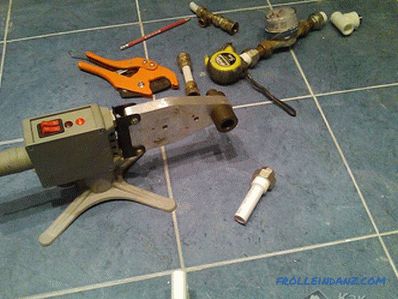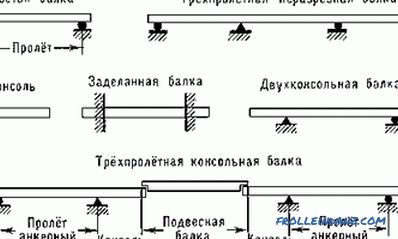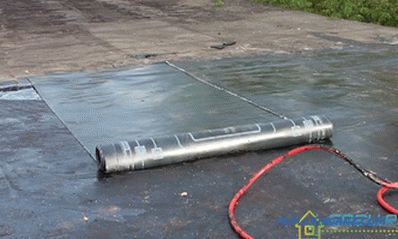If precipitations regularly fall in your area and you are tired of fighting dirt in the yard, then you should seriously consider making a safe path. Today, there are many ideas for their arrangement. One of the materials for these purposes is crushed stone, mainly used in the manufacture of concrete mix. Many homemade craftsmen find non-standard use for it.
Of course, this does not mean at all that the crushed stone should simply be poured onto the ground and slightly tamped. In this case, it simply presses into the ground and nothing remains of it. To solve this problem requires an integrated approach. In this article, we will tell you more about how to make high-quality paths of rubble. You will also learn about the original solution of this problem with the use of this material in different colors.
For what it’s necessary
Tracks perform an important function of landscaping the adjacent territory. They play a particularly important role in the organization of the garden. And if you decide to do a well thought out landscape design, the paths will harmoniously fit into it. So, gravel execution will give your site elegance and well-groomed. Plus, well-groomed and neat paths are evidence of the tidiness and cleanliness of the owners.
 A winding path in the garden bounded by plastic guides
A winding path in the garden bounded by plastic guides
But there is another important function of the tracks - practicality. Their presence creates a kind of ensemble, interconnecting various architectural elements and certain sections of landscape design. They can distinguish between flowerbeds and other floral arrangements, help to focus on individual elements of the garden.
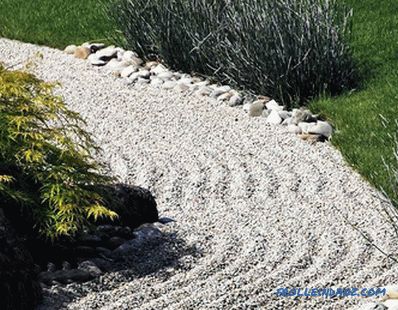 A decorative path around the flowerbed, focuses attention and serves as a beautiful decoration of landscape design
A decorative path around the flowerbed, focuses attention and serves as a beautiful decoration of landscape design
Well, and the main goal tracks - comfortable movement. On them you can move freely even in rainy weather. Dirt from the street will not be brought into the house, respectively, your shoes will remain clean.
Classification
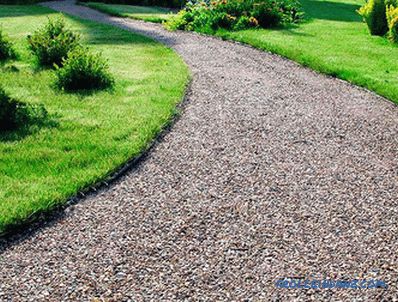 The main path of rubble is wide, due to its displacement towards the side, the space
The main path of rubble is wide, due to its displacement towards the side, the space
All paths in the garden have their own classification; the following types are known:
- The main ones are those that take on the main load in terms of the number of movements per day. This may be the path connecting the house with a wicket, summer kitchen, etc.
- The secondary and connecting - those that, like a circulatory system consisting of vessels, branch off from the main one. Some of them permeate the garden plot, heading for a less significant object. As a rule, their configuration is simple.
So, regardless of the classification of the tracks, they must create a convenient pedestrian zone in the country.
The optimal width
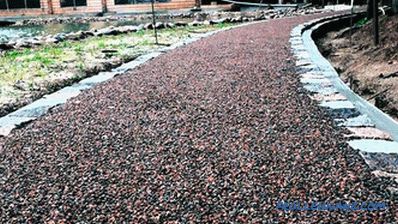 The track has enough width to move
The track has enough width to move
The full width of the track depends on its purpose. For example, the main ones will have a large width, for example, those that connect a house with a wicket, a seating area, etc. The width must be such that 2 people can freely disperse on it, therefore here the size from 0.9 to 1 is considered optimal, 5 m.
If the path leads to outbuildings, then its width cannot be less than the width of the garden wheelbarrow. The ideal setting is 60-90 cm. It is better that the width be greater than the width of the garden cart.
If you have a greenhouse, then the width of the path can be up to 50 cm. This size will also be enough to drive freely with a cart. If you plan to make a path between the beds, then the optimum width is 30-50 cm. Such passages will not take up much space and at the same time will contribute to the quality care of the plants.
Basic principles of designing a pedestrian zone
 The location of the tracks between the beds. Due to this, the care of plants is simplified.
The location of the tracks between the beds. Due to this, the care of plants is simplified.
If the adjacent territory is still at the design stage, the formation of the tracks is performed last. First, you need to plan where the outbuildings, recreation area, garden, greenhouses, etc. will be. The decision about where and how to lay them will come by itself.
When forming a track, it is important to understand that its bulk types imitate streams to some extent. Therefore, it can be a lot of turns, looking as natural as possible. Look at the ready-made options of the garden paths of rubble in this article. You can take original ideas as a basis and connect your imagination to make it even better. You may want to combine the base material with others, such as wood, large stones and so on. But here it is important to consider one moment, the choice of additional material should not create inconvenience when walking.
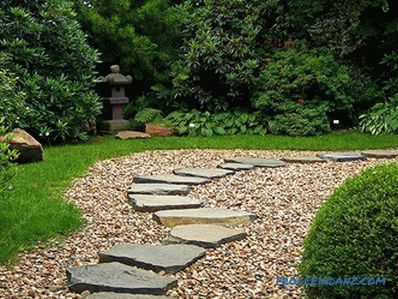 A decorative path made of natural stone and gravel, an excellent combination of
A decorative path made of natural stone and gravel, an excellent combination of
It is also important to determine the scale. Making garden paths should not take a lot of time. Therefore, their number can not be large, otherwise the entire territory will be filled with paths. It is, among other things, bad and aesthetic.
How to visually expand, narrow and reduce the area
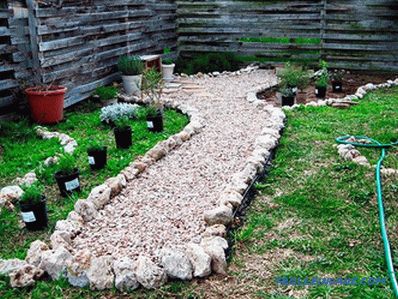 The long path on the site visually lengthens the small area
The long path on the site visually lengthens the small area
When forming a track, it is also important to consider that they can visually expand, reduce, or lengthen a section. So, if you need to visually expand the area, then the passages must be shifted to the side and narrowed. Low bushes are also planted on both sides of the bend, which increases the sensation of width.
If the area should, on the contrary, be reduced, the tracks should be of medium width with a small number of them. Another method is used for lengthening. For this, the width of the path gradually narrows, but not so much that it was inconvenient to walk in the end.
Design Features
Making tracks is a creative process. There are no special rules and regulations regarding their form. It can be symmetrical, asymmetrical, having smooth curves or sharp turns. At the same time, the form of garden paths should be in harmony with the general landscape design.
 The path between the flowerbeds sets accents in landscape design
The path between the flowerbeds sets accents in landscape design
Relief when setting paths
The location and direction of the garden walkways is formed on the basis of the prevailing relief. If the garden is flat, then the tracks can be arranged as you like. If the relief is "saucer-shaped", then the location may resemble the shape of the sun. For example, in the lowest place is a reservoir and from it will go up the trails. If there are drops in the area, the paths should be zigzagging, connecting all parts of the territory with smooth lines. In some places it may be necessary to construct small steps.
Paths from rubble: advantages and disadvantages
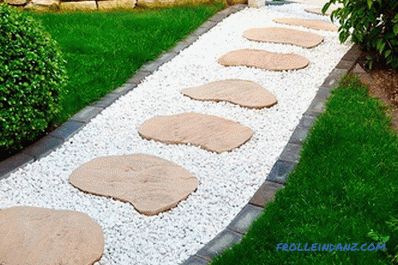 Rubble is perfectly combined with other materials, in this case with a natural stone
Rubble is perfectly combined with other materials, in this case with a natural stone
Before you decide to make tracks from this material, it is worth weighing the pros and cons. To do this, you will help the table of comparative characteristics:
| Benefits | Disadvantages |
| Easy to set up, do not require highly skilled craftsmen. | For some, walking on such a surface is difficult. |
| Ability to combine with other materials, such as paving stone, wood, large stones, etc. | if wrong to prepare the base, although no special actions need to be taken, it will be necessary to conduct constant weed control. |
| Water does not linger, which means that even in the rain you can move freely in them. | Some people think that they do not have a special charm and look rustic. |
| It takes not much time to make a track, as there is no need for special soil preparation and concrete pouring. | If you are used to walking in the country during the warm season barefoot, then you will not walk along the rubble just by bare feet. |
| Low cost. | Gray can get annoying very quickly. |
| The use of special dyes will complement the garden with bright colors. | If you have children, they may be injured if you fall. |
| Virtually no wear, which means a long service life. | It is problematic to remove the snow because of the uneven surface, in addition, there is a risk of clearing the snow along with the frozen rubble. |
| There is no need for special care. | The displacement of gravel will cause craters and potholes. |
| There is no need to arrange drainage. | It creates a lot of dust, especially after driving a car. |
| Before laying the rubble does not need to be washed and cleaned. | |
| After a while, it is easy to repair. If a small hole is formed, then it is enough just to make a bedding. | |
| Even after a large amount of time, you can modify the tracks: give them a special shape or change direction. |
Selection of the type of material
An important role is played by the selection of the corresponding rubble, which differs in the size of the fraction. It is also known several of its varieties, among which:
- shale;
- granite;
- gravel.
The choice depends on the type of soil, the relief of the site and the purpose of the track. Let us compare all these types of rubble with each other:
| View | Specifications |
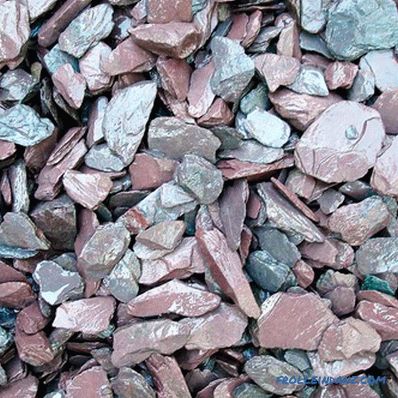 Slate crushed stone Slate crushed stone | There is shale screening, the smallest fraction is 5 mm. It is often used as decorating platforms, etc. The largest fraction reaches 20 mm, it is mainly used for the manufacture of concrete mix. Does not withstand heavy loads, as it is prone to splitting. For the construction of tracks, it is better to purchase quartzite shale crushed stone. It contains mica, which gives the material sufficient strength. |
 Granite rubble Granite rubble | Fractions can be different sizes, for example, crushed stone 5-20 mm is used for decorative finishing. This type of rubble is the most durable. It consists of solid rocks. The material is resistant to low temperatures and high humidity. Ideal for covering walkways. |
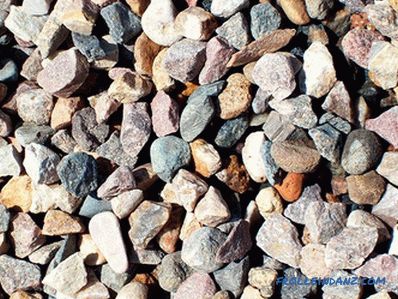 Gravel rubble Gravel rubble | Due to its irregular form, such crushed stone has good adhesion and does not require the manufacture of a drainage layer. |
For the construction of the tracks, the fraction of material can be from 5 to 70 mm. If traffic is envisaged, the fraction should be larger. If it is intended only for pedestrians, then smaller. If the track does perform only a decorative function, then screenings with a fraction of up to 5 mm are used.
Manufacturing steps
 Track made of rubble and fenced with wooden columns
Track made of rubble and fenced with wooden columns
All work consists of several sequential processes:
- marking;
- trench preparation;
- curbing, if necessary;
- manufacturing "pillows";
- backfill of rubble.
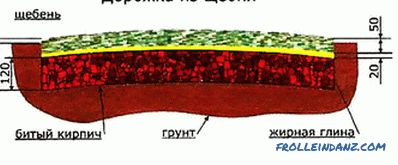 Laying the track of the rubble
Laying the track of the rubble
Required materials and tools for work
For all the work you need to prepare the following:
- Rake.
- Shovel.
- Rammer.
- Clay, sand and large crushed stone to create a "cushion".
- Capacity for mixing components.
- Geotextiles.
- Small crushed stone for the track.
- Curbs.
- Nylon thread.
- Pegs.
Marking the area
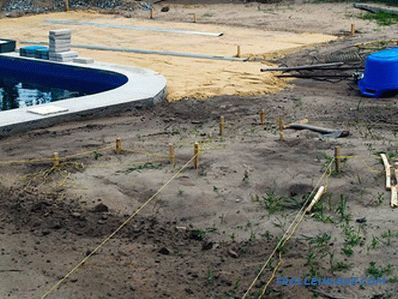 Marking the future track with a rope and a peg
Marking the future track with a rope and a peg
First, it would be nice to draw a small project on a piece of paper. After that, everything is transferred on an enlarged scale to the site. Pegging and nylon thread are used for marking. Between pegs step should be no more than 1 meter. This will allow you to more accurately convey the shape of the future track.
As for the pegs, they should be small. They are hammered into the ground, and the thread is tied to them. If the path is winding, then a rubber hose can be used for marking. When marking, be sure to consider the size of the geofabric.
Digging of trench
After marking, dig a trench for laying rubble. No need to dig too deep. It is enough to remove the top fertile layer or turf - the depth of the pit will be up to 20 cm. The simplest method is to do it: dig along the contours of the track with a bayonet spade, and choose the middle one with a pointed shovel. This method is relevant if the soil in the area without solid impurities.
The pit should be cleaned of all kinds of debris, roots and weeds. The bottom is carefully rammed and poured a layer of sand 5-10 cm, which is also subjected to tamping.
Features of laying geotextiles
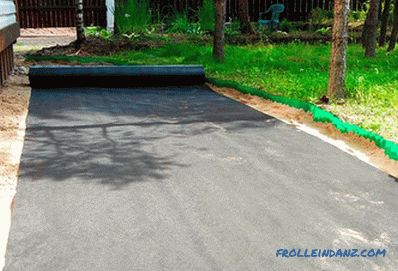 Laying geotextiles under the track, it is important to avoid folds and wrinkles
Laying geotextiles under the track, it is important to avoid folds and wrinkles
From the top of the sand lay geotextiles. Along the edges, it should protrude above the ground level to 10 cm, after the completion of the work, it will simply be necessary to cut it with scissors or a sharp knife. This fabric has no front side, so it can be laid by either side.
When installing the geofabric avoid wrinkles and folds. Each subsequent sheet of geotextile should overlap more than 15 cm.
The choice of fabric for the track and its role
 The geotextile for the track should not be on organic basis
The geotextile for the track should not be on organic basis
The main function of geotextiles is drainage, separation of building materials and protection of gravel from mixing with the soil, preventing the germination of weed roots and shrubs. Given the low loads, it will be sufficient to use a geofabric with a density of 150–200 g / m 2 for the gravel path. Mostly used material from polyester or polypropylene.
It is not recommended to use organic-based cloth. This material is not durable.
If we talk about the role of geotextiles in the track arrangement, here we can single out the following:
- the operational life of the trail increases; 46>
- the walkway cover is protected from the ground;
- geofabric in combination with rubble also serves as an excellent drainage.
Installation of curbs
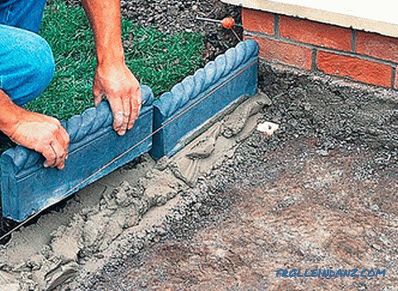 Installation of curbs for a track on a cement pad
Installation of curbs for a track on a cement pad
To gravel does not go beyond the edges of the track, be sure to set the curb, which will serve as a limiter. You can use:
- concrete curb;
- brick;
- natural stone;
- wooden posts or boards;
- plastic etc.
Above the ground level, the curb should rise up to 7 cm. If you plan to use a brick or stone, it is recommended to prepare a cement-sand pillow. If wooden pegs or boards are chosen, they must be treated with a special antiseptic against rotting.
Making a "pillow"
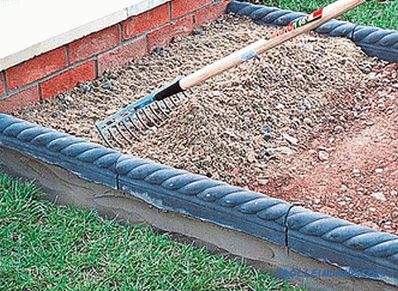 Making a pillow under the walkway; for this, gravel is mixed with clay or sand
Making a pillow under the walkway; for this, gravel is mixed with clay or sand
Be sure to put a “pillow” under the laying of the face layer, which will consist of clay and crushed stone of a large fraction. After pouring the mixture over the geotextile, pour it over with water. After this tamper is carried out. You can also not mix these materials, first to fill the trench with rubble, and after clay, with each layer being filled with water and rammed.
Sand can be used instead of clay, this will increase the drainage properties of the gravel path. In this case, the work looks like this: a geotextile is put, after a large crushed stone, then, again, a cloth and finally sand. The simplest option is to fill the trench with rubble, tamp it down and close with geotextile so that the large fraction does not mix with the small one.
Gravel filling - the final touch
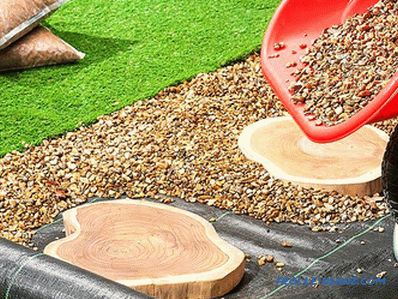 Gravel is filled up on top of the geotextile with a uniform layer
Gravel is filled up on top of the geotextile with a uniform layer
The final stage - backfilling of the trench with the prepared "pillow" with gravel. On average, 1 m 2 consumption will be up to 50 kg, this is assuming that the layer thickness will be up to 3 cm. Accordingly, the material consumption increases with increasing layer. When you are completely covered with rubble, you need to flatten it and ram it.
A decorative path made of colored crushed stone
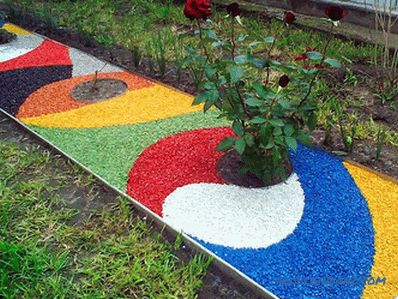 The path may be decorative of colored crushed stone
The path may be decorative of colored crushed stone
If you want to make a decorative path, which will decorate the general appearance of landscape design, you can use colored gravel. Of course, it is already sold, but on the other hand, you can paint this material yourself. The whole process consists of several stages:
- material preparation;
- painting;
- drying.
Video
Material preparation before painting
The fraction of purchased rubble can be varied, as its manufacturer does not sort it for your needs. For sorting often use the device "rumble", through which there is a separation of the small fraction from the large. It is clear that you will not have it, so you can use a metal grid. The desired fraction will slip through the grid, and the large fraction will remain on its surface.
It is worth noting that for painting it is best to use pebbles of a fraction of 10 mm. This size will be ideal for making garden decorative paths.
Video
Paint rubble
 Rubble can be painted in any desired color
Rubble can be painted in any desired color
After that, crushed stone is poured into a concrete mixer. With this device it will be easiest to mix the material with the dye evenly. For dyeing, you should use acrylic or polymer paint. For uniform dyeing, the concrete mixer should be left for one hour in switched on mode.
Drying the dyed material
After the allotted time, the gravel is discharged into the tank. It may happen that paint will remain on the bottom. Strain it through a sieve, and spread the sifted gravel in the open air. Already painted material can be used for the manufacture of decorative paths or flower beds decoration.
So, in this article, we looked at the main points on how to arrange paths in the garden plot so that they would eventually serve more than one year. If you know other ideas or the subtleties of making tracks from rubble, not mentioned in the article, be sure to leave comments at the end of this article.
Video
